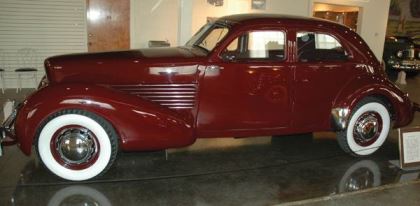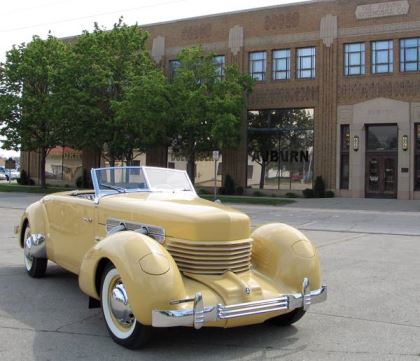By Anna Lee Braunstein, F351629
June 2012
The 1920s are remembered as a time of high living, snazzy dressing, and fast driving. Back then, the place to go to get that fast and flashy car was Auburn, Indiana, called “The Hub of Transportation.” Today a visit to the Auburn Cord Duesenberg Automobile Museum, where more than 120 lustrous vehicles are parked for admiration, shows that the hub was gilded.
Why was Auburn the hub and not the more famous and productive Detroit? The answer to that question begins with Charles Eckhart, who founded the Auburn Carriage Company in the 1870s. His sons, Frank and Morris, saw that carriages were becoming things of the past and that the automobile was the future. In 1903 they began manufacturing automobiles in the renamed Auburn Automobile Company.
From its beginning, the company aimed for speed and quality and was moderately successful. A fire in 1912 destroyed the buildings, and the company relocated. By the early 1920s the business was in trouble, and it was purchased by a group of Chicago businessmen that included William Wrigley Jr., of chewing gum fame. Another Chicagoan, Erret Lobban Cord, arrived from Chicago in 1923. He took the remaining stock of 700 black-colored Auburns, gave them bright paint and shiny nickel plating, and sold off the inventory.
Cord was the person who “gilded the hub.” By late 1925 he owned the entire company. He found success selling cars hand-built for quality, beauty, and speed: the Auburns and Cords. In the mid-1920s, Cord joined with automaker Fred Duesenberg and expanded the inventory of glamorous cars. With their flash and style, these beauties were part of the world of celebrities during the 1930s Depression. Olympic skater Sonja Henie drove a Cord. Errol Flynn’s Auburn Speedster could hit 100 mph. Clark Gable owned a Duesenberg, and Gary Cooper paid $14,000 for his Model J “Duesy.”
E.L. Cord soon owned the Duesenberg company as well, and the companies’ outstanding engineers outfitted the vehicles with features that we now take for granted: unibody construction, superchargers, hideaway headlights, and front-wheel drive. In 1929, up until the economy collapsed, the company had a banner year. Fortune magazine noted that the Auburn was the “biggest package in the world for the price.” According to Business Week, it was “more car for the money than the public has seen.” By 1937 when the company closed, more than 177,000 automobiles had been sold.
The legacy of Auburn, Cord, and Duesenberg continues at the museum. In addition to vehicles made locally, the collection, which spans more than a century, includes Detroit-made Cadillacs and Packards as well as British Rolls-Royces. Signs are placed near each vehicle to describe who owned it, what it cost, or what was happening at the time it was built, thus putting the car into historical perspective.
 The museum building — the former showroom and administrative offices of the Auburn Automobile Company — is itself a work of art, a historically significant example of art deco architecture designed by A.M. Strauss. He incorporated the geometric lines of the popular industrial style throughout the building, from the zigzag-painted ceiling to the gleaming terrazzo floor. This style is a perfect match for the beautiful automobiles that seem to be waiting to be driven out of the showroom.
The museum building — the former showroom and administrative offices of the Auburn Automobile Company — is itself a work of art, a historically significant example of art deco architecture designed by A.M. Strauss. He incorporated the geometric lines of the popular industrial style throughout the building, from the zigzag-painted ceiling to the gleaming terrazzo floor. This style is a perfect match for the beautiful automobiles that seem to be waiting to be driven out of the showroom.
Up the staircase, past the second-floor research and educational centers, are the furnished executive suites where company officers worked. Third-floor galleries include outstanding displays of cars built by other manufacturers. This museum deserves its ranking among the best automobile museums in the country.
Other museums
Auburn is not just home to one museum, no matter how fabulous. You’ll find several more. Right next door, two of the last remaining buildings of the 1903 Auburn Automobile Company are home to the National Automobile and Truck Museum of the United States (NATMUS). These buildings, along with the Auburn Cord Duesenberg Museum, have earned distinction as National Historic Landmarks. But again, what is inside is the major attraction. To quote Don Grogg, executive director of NATMUS, “The cars are not your normal run of day-to-day vehicles you would see out on the road. The collection mainly consists of one-of-a-kind prototypes” or cars once typically owned.
NATMUS has an extensive collection of vehicles from the World War II era. In addition, the museum contains trucks built during the past century. A gallery is dedicated to International Harvester trucks built in nearby Fort Wayne. Nostalgia increases when viewing these trucks parked next to old gas and oil pumps of days long past. And after all the muscle and mass of the trucks, the model and toy museum is an agreeable contrast.
Next, you will want to drive a few miles down the road to explore the National Military History Center, where camouflage has taken over. Within its six galleries, the center pays tribute to members of the U.S. military by presenting the equipment they used. Galleries honor troops from the American Revolution to today, emphasizing 20th-century conflicts.
The “World War II Victory” section is filled with the paraphernalia of the soldiers and the equipment they used as they defeated the Axis powers of Europe. Details of the European and Pacific fronts are presented in life-size dioramas. Home-front exhibits range from the benefits of a Victory Garden to the development of the atomic bomb. Among the many vehicles displayed are staff cars used by generals George Patton and Dwight D. Eisenhower, and a command car used by German field marshal Erwin Rommel. More cars and tanks are parked as if ready for action, while military planes seem to soar overhead.
The “Things They Carried” gallery displays the individual possessions of soldiers from as far back as the 1700s. It includes detailed images of soldiers dressed and armed for conflict. The menus of C rations and MREs (meals ready to eat) show the change in eating habits over the years. These personal items provide a poignant touch to the displays.
Further exhibits recall the Korean, Vietnam, Persian Gulf, Iraq, and Afghanistan wars. The museum gives veterans a place to proudly recall their service and provides tangible lessons for younger generations. Staff and volunteers include veterans with personal knowledge of the conflicts of the latter half of the 20th century.
The entrance fee to the military museum includes admission to the Kruse Automotive and Carriage Museum next door. There, more than 250 years of wheeled transportation are featured. The vehicles reside in a building that previously functioned as the paint shop in the original Auburn Automobile Company. It stands as a monument to days when horses provided power and Auburn built carriages and buggies.
Visiting this museum is like accepting a personal invitation to a car lover’s private showing. It is filled with the collections of three automobile aficionados — Dean Kruse, Bill Cranston, and Jeff Scholl. From late-18th-century carriages to cars recently raced at the Indianapolis Motor Speedway, this collection presents a variety of vehicles. Adding to the cars’ allure are former owner names such as Andy Griffith, Howard Hughes, and President Herbert Hoover.
Custom car designer Carl Casper is the fourth person whose collection is in the museum. He owns a buggy used to transport President Ulysses S. Grant, as well as carriages from Britain’s royal family. Parked near a Batmobile is a Wells Fargo Wagon. The museum also displays a number of classic cars created by Casper, including his super-hot dragster, known as Casper’s Ghost, and the offbeat Paddy Wagon.
Auburn’s homes wear their styles well; among them are Tudor and Colonial designs. You can take a walking tour past 44 dwellings that date from the early 1900s to the 1930s. Among the noted original residents were E.L. Cord and Morris Eckhart, the very people who made Auburn the center of the luxury car industry. A brochure of the tour is available from the DeKalb County Visitors Bureau.
Whether your favorite part of history involves homes, the military, cars, or all three, be sure to take time to explore the past in Auburn, Indiana.
Further Info
DeKalb County Visitors Bureau
500 S. Grandstaff Drive, Suite C
Auburn, IN 46706
(877) 833-3282
(260) 927-1499
www.dekalbcvb.org
Auburn Fall Car Auction
Motorhomers who are car collectors and enthusiasts will want to consider attending the Auburn Fall Collector Car Auction, Swap Meet & Car Corral, which takes place August 30–September 2, 2012, at the Auburn Auction Park. Admission is $25 for the entire weekend or $10 per day. Call ahead if you plan to attend with your motorhome, as ample RV parking is available but can fill quickly (877-906-2437, 260-927-9797).
Area Campgrounds
Please check your favorite campground directory or the RV Marketplace directory, found in the January and June 2012 print issues of FMC and online at FMCA.com, for additional listings.
Bixler Lake Campground (Fairgrounds)
1650 Lake Park Drive
Kendallville, IN 46755
(260) 347-9941
www.campindiana.com/campgrounds/bixlerlake.html
Blue Lake Campground
5453 N. Blue Lake Road
Churubusco, IN 46723
(260) 693-2265
www.bluelakeindiana.com
Circle B Campground on Hogback Lake
5251 W. U.S. 20
Angola, IN 46703
(260) 665-5353
www.circlebpark.com
Fireside Resort RV Park
5612 County Road 11-A
Auburn, IN 46706
(260) 925-6747
www.firesideresort.com
Indian Springs Resort Campground
981 County Road 64
Garrett, IN 46738
(260) 357-5572
www.indianspringsoutdoors.com
Johnny Appleseed Campground
1500 E. Coliseum Blvd.
Fort Wayne, IN 46805
(260) 427-6720

